~ 19 ~
~ The Study of Threes ~
http://threesology.org
Researchers as of 8/29/2019
| Devil's Advocate Series: | ||||||||
|---|---|---|---|---|---|---|---|---|
| 1 | 2 | 3 | 4 | 5 | 6 | 7 | 8 | 9 |
| 10 | 11 | 12 | 13 | 14A 14B |
15 | 16 | 17 | 18 |
| 19 | 20 | 21 | 22A 22B |
23 | 24 | 25 | 26 | 27 |
| 28 | 29 | 30 A | 30 B | 31 | 32 | 33a | 33b | 33c |
| 34 | 35 | 36 | 37 | 38 | 39 | 40 | 41 A | 41 B |
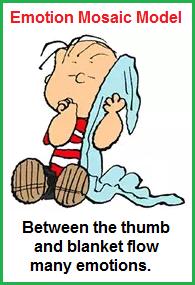
Previously, I have brought to the fore the ideas concerning whether an animal cell has two layers that can viewed as a Bi-lipid (matrix), or three layers which can be viewed as a Trilaminar (process). Instead of "matrix" or "process" one might use alternative designators such as form, model, style, character, profile, etc... Nonetheless, while one might well expect to see three layers in a more complex organism in terms of the variously sighted 1-2-3 developmental schemes played out in other biological processes from the perspective of a timeline appraisal of biological (evolutionary) events; it is rather astonishing to see many biologists stubbornly clinging to the idea of a two-patterned Bi-lipid construction for animal cells and not reflect on the applied behavior of their cognition. It reminds me of a cartoon character clinging to a blanket and sucking their thumb (variously camouflaged with some acceptably designated age-appropriated substitute).
In order to solidify their stubborn insistence for referring to the animal cell as a bi-lipid construct, they have introduced the idea of a "fluid mosaic model" because constituent elements have been identified as... let us say... "oozing" their way between the lipid layers. They are not examining the controversy of the two-versus-three interpretation from an appraisal of human thinking because they are unaware of the numerically identifiable patterns being repeated, not only in biology, but all subjects... aside from those numerical patterns coincidental to their specific interests in terms of drawing up statistical analysis for purposes of charting comparisons, dimensions, changes over time, etc., from experimental observations.
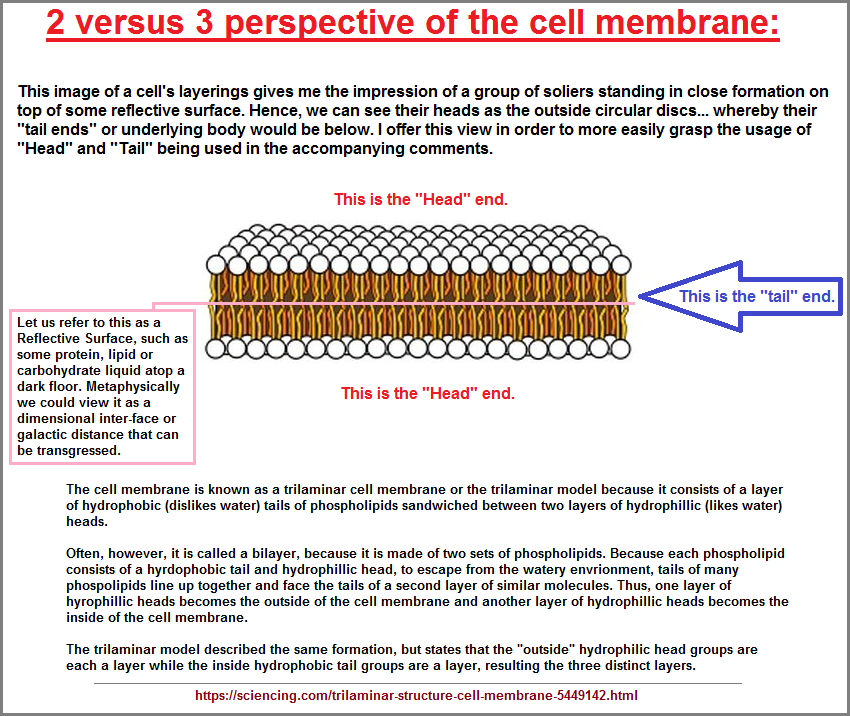
There has been and remains, a controversy between a two- versus- three perception that is comically illustrated by the portrayal of two disputing characters in an old Fresco:
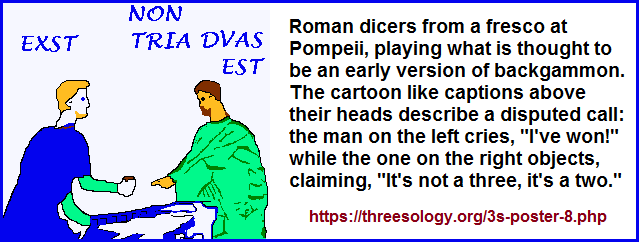
While some readers may not think the "2 versus 3" difference of opinion has any importance so long as respectively opinioned researchers each know what they and their counter-parts are talking about, the fact that it is or is not an issue is the issue in the larger sense of comparative biology when taking in larger amounts of information... including corresponding considerations outside the immediate domain of biology... such as into the fields of mathematics, physics, and chemistry patterns. In short, if we ask if it is a big deal, we should be replying in the affirmative.
It is difficult to take the idea of a "Bi-lipid" layer model very serious knowing the existence of a one-two-three maturational formula exists to make a comparison of evolutionary events. In response to this die-hard approach for those biologists who insist on sinking their teeth into this idea and devouring its contents as if it were THE main meal to be consumed for many biological courses, let me introduce the idea of a "Soggy Sandwich Model" that may be alternatively described as an "Oozing Matrix Model":
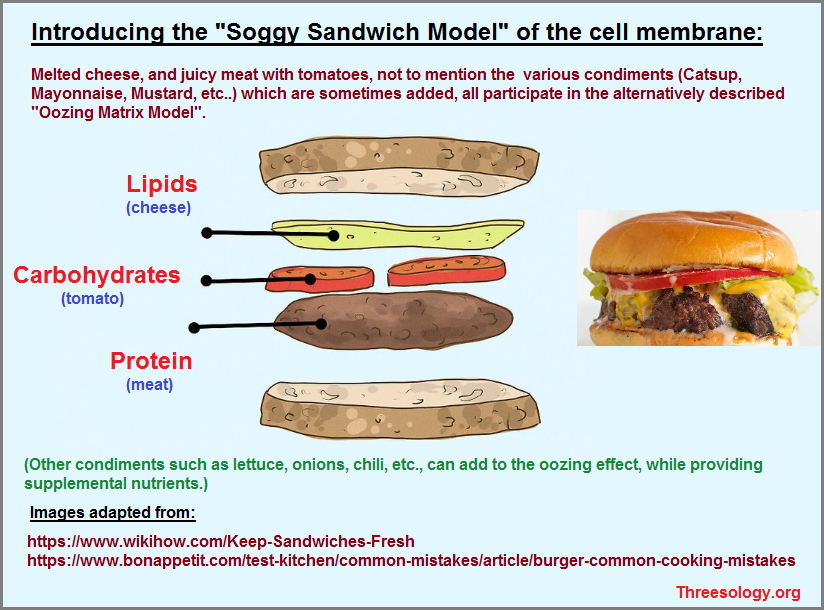
Viewing sandwiches as if they were cells, it is not too difficult to see humans in terms of exhibiting behavior like so many microorganisms that regularly ingest a variety of cell types (sandwiches); both of which engorge themselves on cellular matrices. As an added feature to the 'soggy sandwich model' menu of discussion, let me provide a one-two-three schematic of the commonly offered commercialized hamburger offered at so may "fa(s)>t"-food restaurants:
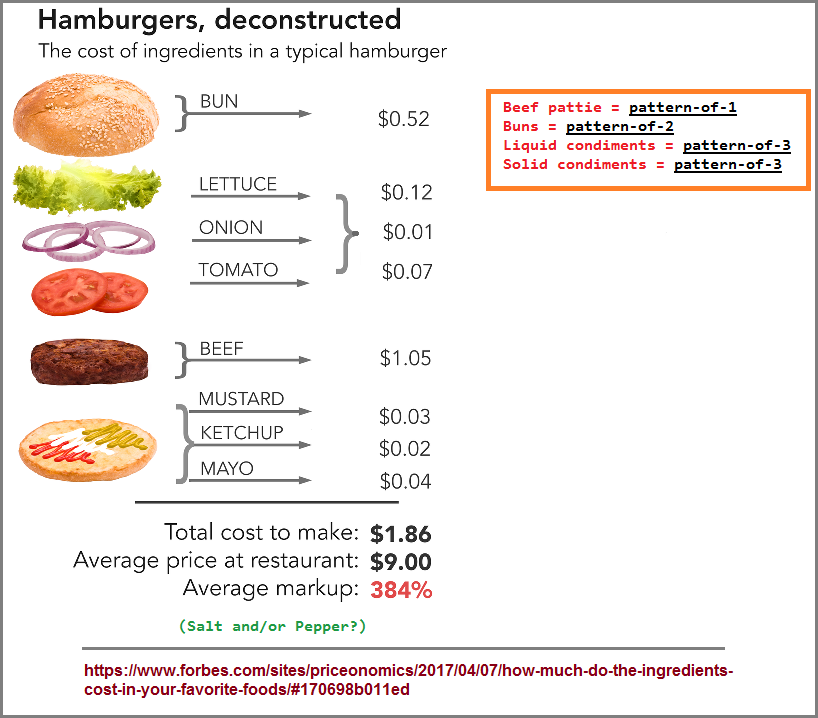
The Big Deal is that in terms of a presumed one- two- three developmental sequence... even if each stage is not readily identifiable in all cases or even if a stage appears to be particularly absent; one might rightly assume that a later developing animal cellular process would be evolutionarily more advanced than a plant cell... yet biologists have no difficulty in distinguishing a pattern-of-three membrane in (assumedly more primitive) plants, yet insist on a (evolutionarily more primitive) pattern-of-two for animal cells. Then again, is the two-versus-three patterning a good sign to mark out the assumed earlier occurring primitive development to an assumed later occurring complex (assumed: advanced) development? In other words, can we use the cardinal scale of numbers to point out relative developmental growth, thus providing us with a similitude of position called an ordinal scale?
A Cardinal Number is a number that says how many of something there are, such as one, two, three, four, five.
An Ordinal Number is a number that tells the position of something in a list, such as 1st, 2nd, 3rd, 4th, 5th etc.
Most ordinal numbers end in "th" except for the first three numbers:
- One ⇒ first (1st)
- Two ⇒ second (2nd)
- Three ⇒ third (3rd)
(H.O.B. note: These first three numbers can be described as historically being viewed as the initial 1-stop→ gap (before the 2)... 2-stop→ gap before the 3)... stop-gapstop→ gap (before the successive development of larger compounded values). They are the stepping stones of primitive thinking in terms of developing concepts of quantity associated to pictures which later became words that were eventually associated to number symbols).
(1-9 = one symbol; 10-99 = 2 symbols; 100-999 = 3 symbols;, etc...)
| Cardinal | Roman | Ordinal |
| 1: One | I= 1 symbol | 1st: First |
| 2: Two | II= 2 symbols | 2nd: Second |
| 3: Three | III= 3 symbols | 3rd: Third |
| 4: Four | IV= 2 symbols | 4th: Fourth |
| 5: Five | V= 1 symbol | 5th: Fifth |
| 6: Six | VI= 2 symbols | 6th: Sixth |
| 7: Seven | VII= 3 symbols | 7th: Seventh |
| 8: Eight | VIII= 4 symbols | 8th: Eighth |
| 9: Nine | IX= 2 symbols | 9th: Ninth |
| 10: Ten | X= 1 symbol | 10th: Tenth |
| 11: Eleven | XI= 2 symbols | 11th: Eleventh |
| 12: Twelve | XII= 3 symbols | 12th: Twelfth |
| 13: Thirteen | XIII= 4 symbols | 13th: Thirteenth |
| 14: Fourteen | XIV= 3 symbols | 14th: Fourteenth |
| 15: Fifteen | XV= 2 symbols | 15th: Fifteenth |
| 16: Sixteen | XVI= 3 symbols | 16th: Sixteenth |
| 17: Seventeen | XVII= 4 symbols | 17th: Seventeenth |
| 18: Eighteen | XVIII= 5 symbols | 18th: Eighteenth |
| 19: Nineteen | XIX= 3 symbols | 19th: Nineteenth |
| 20: Twenty | XX= 2 symbols | 20th: Twentieth |
| ETC..................... | ||
Cardinal, Ordinal and Nominal Numbers
The reason for displaying the above chart is to provide a visual representation of the presumption that what comes 1st in an order will also display a "one" symbol... and so on. Yet, if this is not the case in the "real world" of organic or inorganic substances in all cases (let us also include ideas related to alternative considerations that might also be construed as spiritual, metaphysical, super-natural, science-fiction, etc...), then that which appears 1st, or 2nd, or 3rd... etc., may not exhibit a "1" (or a "2" or a "3") profile. An item can be first in an evolutionary or development sense but need not exhibit only a "1" or singular profile characteristic. If something is first but exhibits a two-patterned structure, and then that which is 2nd exhibits a geometric form, and then the 3rd development exhibits that which may be described as lacking any familiar design or organization, will we thus overlook and not name the sequence as a pattern-of-three? Will we permit ourselves an extensive latitude for interpreting the presence of a pattern-of-three (or any pattern), or does this then present us with such an arbitrary formula of analysis that we fall prey to an "anything goes" situation, whereby no standard system of referencing is even permitted, because it preferentially allows for some interpretations but not others? Then again, all systems of interpretation are based on some measure of arbitrariness which becomes standardized as the "arbitrariness of choice"... regardless if the choice is accepted by those labeled as professionals or intelligent people. However, since history is replete with examples of professionals and intelligent people rejecting an idea that is later found to be one, two, or three steps forward from the then adopted practices, is it not of value to embrace some level of skepticism with an opportunistic degree of entrepreneurial supposition of giving the benefit of a doubt? In other words, we must be cautious in our allowances so that we don't paint ourselves into a corner for which we have not provided ourselves with a means to advantage a retreat.
Philosophically speaking, let us ask if a duality more primitive than a trichotomy... and though we might try to continue this co-ordination of thought with a mathematical rigor to suggest that a trichotomy is more primitive than a 'quadrotomy'... etc..., this may not be the case with respect to the impositions placed on biology, human physiology and human psychology by the present incrementally deteriorating environmental conditions. In other words, whereas in a different environment one might well state as a fact that patterns exceeding the former numerical assignments are in-turn more primitive from advancing numerical values, the present state of the environment is forcing a limitation on the extent to which such a logic of enumeration can be applied. Hence, like the 3 stop codons and 1 start codon, humanity is confronted by the same overall biological and psychological constraints... despite efforts to imaginatively suggest limitlessness by various modes and manners of creative rationalizations to state otherwise.
Like our usage of a comma after the third number (groups of three numbers) in the place value system of the commonly used base 10 mathematics:
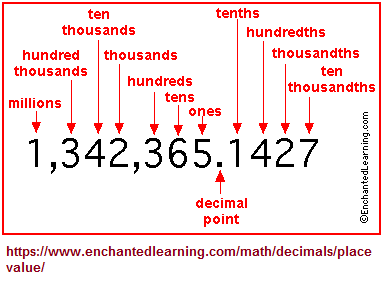
Yet, when we look at the usage of a comma as a means of separating thought processes in terms of writing, we find that there is an over-riding (dominant) insistence of separating two items, which gives the impression of dichotomous thinking: [Information culled and adapted from "Rules for Writers, sixth edition, dianahacker.com/rules", ISBN-10: 0-312-59339-2, ISBN-13: 978-0-312-59339-1 (student edition)]
Use a comma:
- Between coordinating junctions joining independent clauses.
- Between an introductory clause or phrase and sentence completion.
- Between two or more items in a series.
- Between coordinate adjectives not joined with and.
- To set off non-restrictive elements.
- To set off transitional and parenthetical expressions, absolute phrases, and elements expressing contrasts.
- To set off nouns of direct address, the words yes and no, interrogative tags, and mild interjections.
- With expressions such as he said, to set off direct quotations.
- With dates, addresses, titles, and numbers.
- To prevent confusion.
Do not use a comma:
- Between compound elements that are not independent clauses.
- Before the first or after the last item in a series.
- Between cumulative adjectives, between an adjective and a noun, or between an adverb and an adjective.
- To set off restrictive or mildly parenthetical elements.
- To set off a concluding adverb clause that is essential to the meaning of the sentence.
- To separate a verb from its subject or object.
- After a coordinating junction (and, but, or, nor, for, so yet).
- After such as or like.
- Before than.
- After although.
- Before a parenthesis.
- To set off an indirect (reported) quotation.
- With a question mark or exclamation point.
And yet... we do find patterns-of-three in writing:
In the English language, conjunctions come in three basic types: the coordinating conjunctions, the subordinating conjunctions, and the correlative
conjunctions. (Part Of Speech)
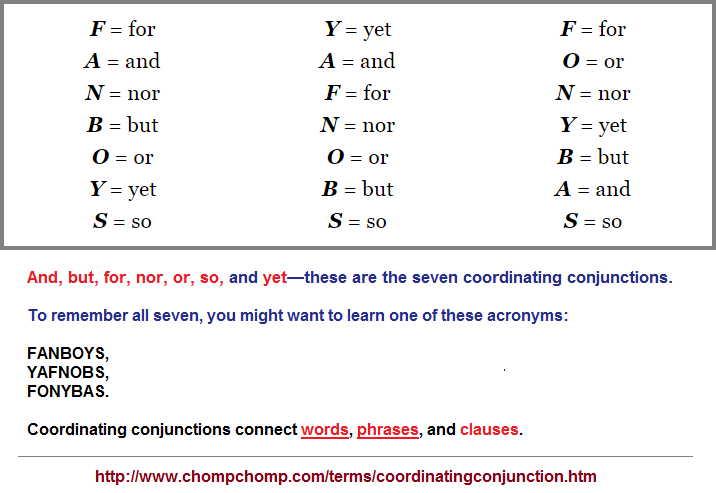
(Look at the one- two- three compilations in the following types of sentences.)
- A Simple Sentence has ONE independent clause.
- A Compound Sentence has TWO independent clauses joined by:
- a coordinating conjunction (for, and, nor, but, or, yet, so),
- a conjunctive adverb (e.g. however, therefore), or
- a semicolon alone.
- A Complex Sentence has ONE dependent clause (headed by a subordinating conjunction or a relative pronoun) joined to an (ONE) independent clause.
- A Compound-Complex Sentence has TWO independent clauses joined to ONE or more dependent clauses.
|
Here are a handful of "threes"- related references to writing and language:
And let me collectively add the known three-languages (scripts) inscribed stones to the above list:  |
The reason for the lengthy digression into providing examples from the written form of language and denoting the presence of multiple dichotomies, is that a language model is sometimes employed as an analogy towards illustrating functionality in biological processes. A good example is the rendering of the genetic code into an interpretation consistent with words, letters and sentences, as well as punctuation. However, in as much as one might find this a useful tool, since letters instead of numbers are used to identify the different amino acids, we need to be wary of any inclination that one or another researcher may be inclined to adopt a dominant "two" orientation; whereby the presence of a "three" pattern will become diminished to a minor position of interest, as we see in the case of the animal cell membrane interpretation. This is the case when one consciously or unconsciously preferences using a right-brain hemisphere interpretation (which is dominated by patterns-of-two), instead of a left-brain hemisphere interpretation (which is dominated by patterns-of-three), as seen on page 10 of this Devil's Advocate series.
In mathematics we find a basic three-patterned formula: one number... plus subtract, multiply, or divide another (2nd) number, to get a 3rd number. Writing, on the other hand, appears to have a basic two-patterned formula of making contrasts... or the usage of addition, subtraction, division and multiplication to achieve a solidification of one or two. In other words, any third (or more) is used to support the position of a single or a double. For example, a couple may decide to buy a house by combining two incomes, but the result is not a third income... it is an acquired resource to support the two incomes. Whereas one may argue the house has an increasing equity that could be sold or mortgage for a third income... the received monies are either conjointly owned or separated into to equal singularities. There is no decisive third income to be realized in this instance, though both may have more money than they originally had. They have separate singular accounts. The 1 + 1 is not cumulative in the same sense as a formalized enumeration found in number usage.
Another example is the usage of a two-patterned orientation involving various yin/yang dualities which may have first been adopted to indicate opposition, but were later interpreted to express a complementarity. Yet, the arisen complimentarily does not evolve into a separate life form. There is no property of emergence into individuality... into a self-replication... only a sustained symbiosis. It's like an effort is being made to make a transition, but the full transition into a separated state of individuality is never truly realized. Instead, everything that emerges is viewed in terms of a former "two" positioned orientation.
This may be what we are witnessing in the circumstance of the animal cell. It is showing us both a two and three-patterned representation, because it is in a state of developmental transition from a two to an actual three-state, whereas the plant cell has already evolved into its own independently respective "three-state". Unless of course the animal cell is a three-state and the efforts of those with a preferred two-patterned orientation create supportive ideas so as to profit their preference of orientation. Then again, if the animal cell is still evolving, can we predict its eventual outcome? Can we predict where it is headed by interpreting where the plant cell has gone... in terms of its present three-patterned structure?
Since biological processes exhibit low (numerically identifiable) patterns of function and growth, this conservation must be due to an environmental imposition related to an equilibrium adjusting to an on-going rate of incremental deterioration. What I mean by low numbers is that the many examples of "threes" models of functions and designs being uncovered by different researchers in biology and other subject areas, typically revolves around representations that do not have multiple expressions beyond values of ten... and in most cases much lower than this. (I say "ten" to be generous and am attempting to be amicable to those who may be resentful to my repeated usage of "three" and associated number companions.) While there are number values which can greatly exceed low numbers when compounded through additions and multiplications, we do not typically find patterns of function or form in the multiples of ten, hundreds, thousands, etc... However, while we can cite the existence of billions of life forms, or billions of cells, or billions of atoms, this is a cumulative effect of singular forms and functions.
Origination date: Saturday, September 16th, 2019... 12:52 AM
Initial Posting: Tuesday, September 18th, 2019... 6:13 AM
Updated Posting:Tuesday, January 17th, 2023... 12:32 AM
Herb O. Buckland
herbobuckland@hotmail.com